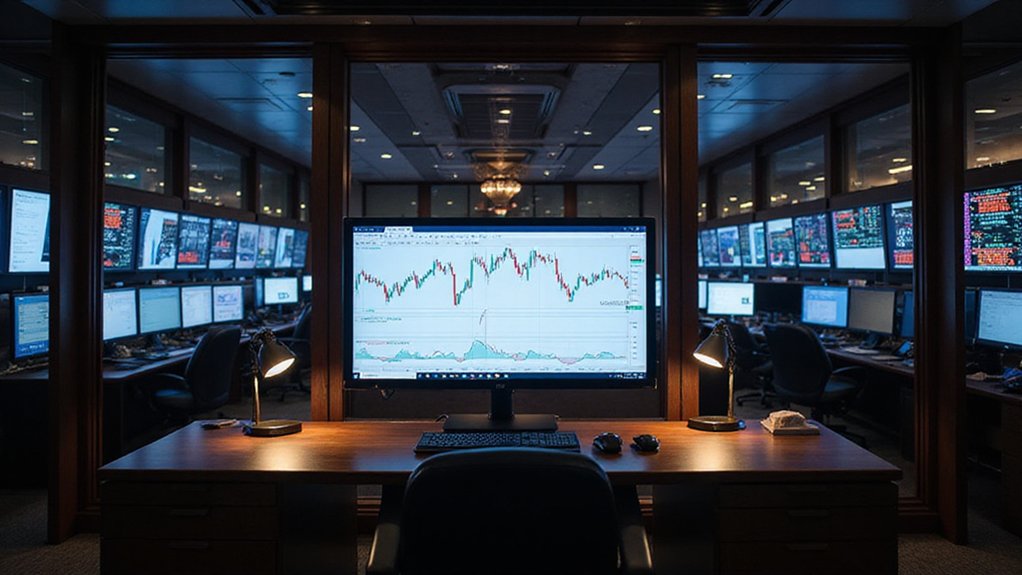The cryptocurrency OTC market functions as an institutional shadow economy where hedge funds, miners, and corporate treasuries execute massive digital asset transactions outside public exchanges to avoid the inconvenient reality of moving markets against themselves. These direct counterparty deals offer enhanced privacy, aggregated liquidity, and faster settlement—though participants trade exchange protections for counterparty risk and opaque pricing that would make traditional market makers blush. The regulatory landscape remains predictably murky, yet sophisticated participants continue expanding this parallel universe that processes billions while maintaining Swiss-level discretion, creating a fascinating ecosystem where traditional finance meets digital innovation.

While most cryptocurrency enthusiasts obsess over the theatrical price movements displayed on public exchanges—those mesmerizing green and red candles that flicker across trading screens like a financial light show—the real heavy lifting in digital asset markets occurs in the shadows of over-the-counter (OTC) trading desks.
OTC crypto trading represents the purchase and sale of digital assets conducted entirely outside public exchanges, specifically engineered for large-scale transactions that would otherwise send conventional order books into convulsions. When institutional investors or high-net-worth individuals need to move substantial volumes without triggering the kind of price volatility that makes exchange traders reach for antacids, they turn to OTC desks—specialized platforms that match buyers and sellers with the discretion of Swiss bankers and the efficiency of experienced matchmakers.
These transactions bypass the public spectacle entirely, with deals negotiated directly between counterparties or facilitated by brokers who customize everything from pricing to settlement methods. The appeal is obvious: executing a $50 million Bitcoin trade on a public exchange would likely move markets like a boulder dropped into a pond, whereas OTC trading allows such transactions to occur without so much as a ripple in publicly visible prices.
The advantages extend beyond mere market impact mitigation. OTC desks aggregate liquidity from multiple sources, provide enhanced privacy (since trades never appear in public order books), and offer faster settlement processes with flexible payment options including bank transfers and escrow services. These platforms enable peer-to-peer systems where large investors can transact directly without the need for traditional exchange intermediaries. Participants typically include hedge funds, family offices, crypto miners liquidating substantial holdings, and corporate treasury departments managing digital assets for balance sheet optimization. The growing sophistication of this market parallels the explosive growth in stablecoin market cap, which has reached all-time highs near $250 billion as these digital assets become essential infrastructure for large-scale cryptocurrency transactions.
However, this shadow market carries distinct risks that would make traditional exchange traders blanch. Counterparty risk looms large—one party’s default can cause significant financial loss without the safety nets provided by regulated exchanges. OTC prices may deviate substantially from public market rates due to negotiation dynamics and seller reputation, while the absence of transparent pricing creates opportunities for manipulation that would make even seasoned traders wary. The digital nature of these assets means that irreversible transactions can lead to permanent losses if errors occur or if parties act in bad faith.
The regulatory landscape remains murky, with compliance requirements varying by jurisdiction and transaction nature, leaving participants to navigate an environment where legal recourse options pale compared to exchange-based trading protections.
Frequently Asked Questions
What Are the Minimum Trade Amounts for OTC Cryptocurrency Transactions?
OTC cryptocurrency desks typically impose minimum trade thresholds ranging from $10,000-$30,000 for retail-focused platforms to $1 million or 25 BTC for institutional-grade services.
Mid-tier desks generally require $50,000-$100,000 minimums, while corporate-level transactions often exceed $50 million.
These thresholds reflect operational costs, compliance requirements, and the fundamental premise that OTC trading exists to facilitate large transactions—smaller amounts hardly justify the elaborate infrastructure these desks maintain.
How Do OTC Trading Fees Compare to Regular Exchange Fees?
OTC trading fees operate through negotiated arrangements rather than exchanges’ transparent tiered structures, creating an interesting paradox where larger trades secure better pricing while smaller investors face predetermined schedules.
Exchanges charge 0.40-0.60% for retail traders, dropping to 0.10-0.20% at institutional volumes, yet OTC desks often undercut these rates for substantial transactions.
The trade-off? Exchanges offer predictable costs; OTC provides customized pricing wrapped in opacity—transparency versus potentially superior economics.
Can Retail Investors Access OTC Cryptocurrency Markets?
Retail investors can theoretically access OTC cryptocurrency markets, though the reality proves considerably more constrained than traditional exchange trading.
Most OTC desks impose substantial minimum transaction requirements—often hundreds of thousands of dollars—effectively excluding casual participants.
While some platforms accommodate smaller investors, the economics rarely favor retail traders: higher fees, reduced liquidity, and limited regulatory protections create an environment where institutions naturally dominate these private trading venues.
What Documentation Is Required to Start OTC Cryptocurrency Trading?
Starting OTC cryptocurrency trading requires extensive documentation: KYC verification through government-issued identification, proof of address via utility bills, and source-of-funds documentation.
Traders must maintain detailed transaction records, comply with AML-CFT policies, and submit regulatory reports like SARs for suspicious activities.
Professional operations necessitate formal trade agreements, escrow arrangements, and security protocols.
The paperwork burden—ironically substantial for a “decentralized” asset class—reflects regulators’ determination to impose traditional banking compliance standards.
Are OTC Cryptocurrency Trades Reported to Tax Authorities?
OTC cryptocurrency trades occupy a reporting gray area that’s becoming increasingly less gray.
While traditional exchanges must report transactions to tax authorities (particularly with 2025’s Form 1099-DA requirements), OTC desks operate through private negotiations with historically inconsistent reporting standards.
However, taxpayers remain responsible for reporting all crypto transactions regardless of third-party forms—making meticulous record-keeping essential for OTC traders maneuvering this evolving compliance landscape.









